Family name: Zingiberaceae Martinov
Synonym(s): Alpiniaceae Link; Amomaceae J. St.-Hil., nom. illeg.; Curcumaceae Dumort.
Common name(s): ginger family
*Number of genera/species: 50/1,600
List of genera records in GRIN-Global
fruit or seed
Fruit a loculicidalloculicidal:
type of capsular dehiscence, opening longitudinally through the locules (compare septicidal)
 capsulecapsule:
capsulecapsule:
a dry, dehiscent fruit derived from a compound ovary , rarely berryberry:
, rarely berryberry:
an indehiscent, fleshy fruit with one or a few to many seeds. The flesh may be homogenous throughout. Or, if the outer part is hard, firm, or leathery, referred to as an hesperidium. Septa are present in some, and the seeds may be arillate or with a fleshy testa.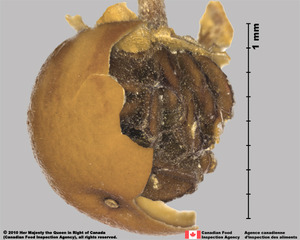 , 4–130 mm long, globoseglobose:
, 4–130 mm long, globoseglobose:
3D shape—more or less spherical to toruloseknotted:
to toruloseknotted:
3D shape—a cylindrical or ellipsoid body that is swollen and constricted at intervals; torulose , angledangular:
, angledangular:
2D shape—having sides that meet at acute or obtuse angles
or tereteterete:
approximately circular in cross section; width and thickness approximately equal
 in transection, sometimes sepalssepal:
in transection, sometimes sepalssepal:
a member of the outer envelope of a flower (calyx) and bracts apically persistent, with few to many seeds. Fruits sometimes with crispedcrisped:
and bracts apically persistent, with few to many seeds. Fruits sometimes with crispedcrisped:
irregularly curled, wavy or crinkled
, undulateundulate:
wavy-margined
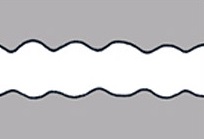 to crenulatecrenulate:
to crenulatecrenulate:
finely crenate (scalloped)
wings. Pericarppericarp:
fruit wall or fruit coat
orange, yellow, purple, green, gray, black, or brown, shinyshiny:
uniformly reflecting a high proportion of incident light at all angles or dulldull:
or dulldull:
reflecting only a low proportion of incident light, with no apparent sheen , dry or fleshy, smooth, wartywarty:
, dry or fleshy, smooth, wartywarty:
surface relief—distinct, rounded projections that are large relative to the fruit size; tuberculate, verrucose , wrinkledwrinkled:
, wrinkledwrinkled:
surface relief—shallow, irregular folds and furrows covering the surface; appearing overall though crumpled and then spread out , ribbedribbed:
, ribbedribbed:
surface relief—wide, prominent, linear ridges that are generally rounded and longitudinally situated on the surface , striatestriate:
, striatestriate:
surface relief—having fine, parallel lines, grooves or ridges , or soft spinyspiny:
, or soft spinyspiny:
having slender, stiff, sharp projections oriented in the general plane of the structure , sometimes with white, brown, or red hairs.
, sometimes with white, brown, or red hairs.
Seeds globoseglobose:
3D shape—more or less spherical to angularangular:
to angularangular:
2D shape—having sides that meet at acute or obtuse angles
, 1.5–7 mm long, often with a thin, white (or yellow to red) veillike, lobed arilsaril:
(broad sense) appendicular structure that wholly or partly envelops a seed and is produced from or a modification of the funicle, raphe, or outer integument; usually fleshy or pulpy, sometimes spongy or tufted-capillate, often brightly colored adnate to hilahilum:
adnate to hilahilum:
on seeds, the scar indicating where the funiculus was attached; on grass caryopses, the scar visible on the outer fruit surface revealing where the seed is attached on the inner fruit wall surface; or in Asteraceae cypselae, the scar visible on the outer fruit wall revealing where the fruit was attached to the receptacle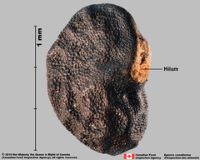 . Each seed with an operculumoperculum:
. Each seed with an operculumoperculum:
a dehiscent cap (or lid) of a seed or fruit that opens during germination or dehiscence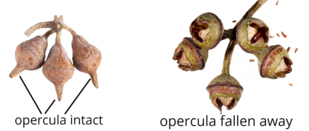 next to the radicleradicle:
next to the radicleradicle:
the embryonic root of the embryo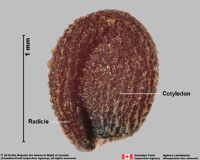 (absent in Hedychieae). Seed coat phytomelan-encrusted, black, red, yellow, purple, brown, or gray, shinyshiny:
(absent in Hedychieae). Seed coat phytomelan-encrusted, black, red, yellow, purple, brown, or gray, shinyshiny:
uniformly reflecting a high proportion of incident light at all angles , wrinkledwrinkled:
, wrinkledwrinkled:
surface relief—shallow, irregular folds and furrows covering the surface; appearing overall though crumpled and then spread out or wartywarty:
or wartywarty:
surface relief—distinct, rounded projections that are large relative to the fruit size; tuberculate, verrucose .
.
Embryo well developed, linearlinear:
(shape) long, narrow, and uniform in width; (of embryo) embryo is straight and much longer than wide , straight, partially filling seed coat, extending into a depression or cup.
, straight, partially filling seed coat, extending into a depression or cup.
Perispermperisperm:
seed nutritive tissue comparable to the endosperm, but derived from the nucellus (maternal tissue)
copious.
| Fruit | |
| Type | capsulecapsule: a dry, dehiscent fruit derived from a compound ovary  , rarely berryberry: , rarely berryberry:an indehiscent, fleshy fruit with one or a few to many seeds. The flesh may be homogenous throughout. Or, if the outer part is hard, firm, or leathery, referred to as an hesperidium. Septa are present in some, and the seeds may be arillate or with a fleshy testa.  |
| Size range | 4–130 mm long |
| Shape(s) | globoseglobose: 3D shape—more or less spherical  , oblongoblong: , oblongoblong:2D shape—much longer than broad with nearly parallel sides, corners are rounded  , flask-shapedflask-shaped: , flask-shapedflask-shaped:3D shape—generally circular in cross-section, broadest at or below the middle, approximately globose below that and constricted above to a relatively narrow neck , ellipsoidellipsoid: 3D shape—elliptic , ovoidovoid: 3D shape—ovate  , trigonoustrigonous: , trigonoustrigonous:3D shape—having three faces that meet at distinct angles; triangular in outline , teardrop-shapedteardrop-shaped: 2D shape—widest point is toward one end of the fruit, the other end tapers sharply to a pointed end 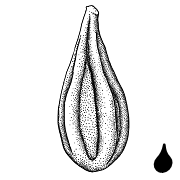 , fusiformfusiform: , fusiformfusiform:spindle-shaped; broadest at the middle and tapering at both ends 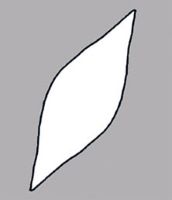 , conicalconical: , conicalconical:3D shape—cone-shaped, with the point of attachment at the broad end 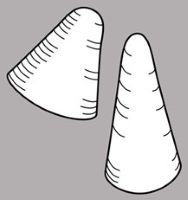 , toruloseknotted: , toruloseknotted:3D shape—a cylindrical or ellipsoid body that is swollen and constricted at intervals; torulose  |
| Texture | dry, fleshy |
| Surface relief | smooth, wartywarty: surface relief—distinct, rounded projections that are large relative to the fruit size; tuberculate, verrucose  , wrinkledwrinkled: , wrinkledwrinkled:surface relief—shallow, irregular folds and furrows covering the surface; appearing overall though crumpled and then spread out  , ribbedribbed: , ribbedribbed:surface relief—wide, prominent, linear ridges that are generally rounded and longitudinally situated on the surface  , striatestriate: , striatestriate:surface relief—having fine, parallel lines, grooves or ridges  , spinyspiny: , spinyspiny:having slender, stiff, sharp projections oriented in the general plane of the structure  |
| Color(s) | gray, brown, yellow, green, orange, purple, black |
| Unique features | Usually brightly-colored, loculicidalloculicidal: type of capsular dehiscence, opening longitudinally through the locules (compare septicidal)  capsulescapsule: capsulescapsule:a dry, dehiscent fruit derived from a compound ovary  with arillate seeds. with arillate seeds. |
| Seed | |
| Size range | 1.5–7 mm long |
| Shape(s) | polygonalpolygonal: angular , globoseglobose: 3D shape—more or less spherical  , oblongoblong: , oblongoblong:2D shape—much longer than broad with nearly parallel sides, corners are rounded  , ovoidovoid: , ovoidovoid:3D shape—ovate  , conicalconical: , conicalconical:3D shape—cone-shaped, with the point of attachment at the broad end  |
| Color(s) | black, red, purple, brown, gray, yellow |
| Unique features | Arillate seeds encrusted with phytomelanphytomelan: carbonaceous, opaque material that usually covers the seed coat to give it a black appearance, common in certain monocot families 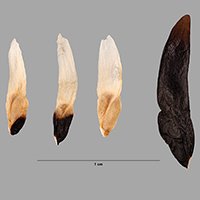 and each with an operculumoperculum: and each with an operculumoperculum:a dehiscent cap (or lid) of a seed or fruit that opens during germination or dehiscence  . . |
| Other | |
| Embryo | well developed, linearlinear: (shape) long, narrow, and uniform in width; (of embryo) embryo is straight and much longer than wide  , straight, partially filling seed coat, extending into a depression or cup , straight, partially filling seed coat, extending into a depression or cup |
| Nutritive tissue | perispermperisperm: seed nutritive tissue comparable to the endosperm, but derived from the nucellus (maternal tissue) copious |
Tropical, subtropical regions.
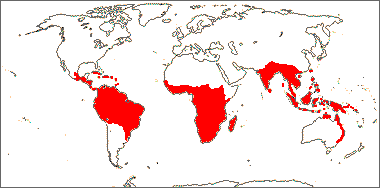
Distribution map courtesy of Angiosperm Phylogeny Website.
Baskin and Baskin 2021Baskin and Baskin 2021:
Baskin C and Baskin J. 2021. Relationship of the lateral embryo (in grasses) to other monocot embryos: A status up-grade. Seed Science Research 31 (3): 199-210. doi:10.1017/S0960258521000209; Benedict et al. 2015Benedict et al. 2015:
Benedict JC, Smith SY, Collinson ME, Leong-Scaron;korničkovaacute; J, Specht CD, Marone F, Xiao X, and Parkinson DY. 2015. Seed morphology and anatomy and its utility in recognizing subfamilies and tribes of Zingiberaceae. American Journal of Botany 102 (11): 1814-1841. https://doi.org/10.3732/ajb.1500300; Dahlgren et al. 1985Dahlgren et al. 1985:
Dahlgren RMT, Clifford HT, and Yeo PF. 1985. The families of the monocotyledons: structure, evolution, and taxonomy. Springer-Verlag, Berlin. 520 pp.; Davidse et al. 2009–2018Davidse et al. 2009–2018:
Davidse GM, Sousa Sánchez M, Knapp S. and Chiang Cabrera F, eds. 2009–2018. Flora Mesoamericana. Missouri Botanical Garden, St. Louis, MO. Accessed: January–April 2024. URL: http://legacy.tropicos.org/Project/FM; Kirkbride et al. 2006Kirkbride et al. 2006:
Kirkbride JH, Jr, Gunn CR, and Dallwitz MJ. 2006. Family guide for fruits and seeds, vers. 1.0. Accessed September 2020-January 2022. URL: https://nt.ars-grin.gov/seedsfruits/keys/frsdfam/index.cfm .; Kubitzki et al. 1990+Kubitzki et al. 1990+:
Kubitzki K et al., eds. 1990+. The families and genera of vascular plants. 7+ vols. Berlin etc.; Lock 1985Lock 1985:
Lock JM. 1985. Zingiberaceae. In: Polhill RM, ed. Flora of Tropical East Africa. Vol 197. AA Balkema, Rotterdam, Netherlands. 40 pp.; Stevenson and Loconte 1995Stevenson and Loconte 1995:
Stevenson DW and Loconte H. 1995. A cladistic analysis of monocot families. In: Rudall PJ, Cribb PJ, Cutler DF, and Humphries CJ, eds. Monocotyledons: Systematics and Evolution. Royal Botanic Gardens, Kew.; Takhtajan 2009Takhtajan 2009:
Takhtajan A. 2009. Flowering plants: Second edition. Springer Nature, Switzerland. 871 pp.; Thiele and Adams 2014Thiele and Adams 2014:
Thiele KR and Adams LG. 2014. Families of Flowering Plants of Australia. Accessed January-December 2021. URL: https://keys.lucidcentral.org/keys/v3/FFPA/key/FFPA/Media/Html/index.htm; Watson and Dallwitz 1992+Watson and Dallwitz 1992+:
Watson L and Dallwitz MJ. 1992+. The families of flowering plants: descriptions, illustrations, identification, and information retrieval. Version: 6th Accessed September 2020-September 2022. URL: delta-intkey.com; Zhengyi et al. 2004+Zhengyi et al. 2004+:
Zhengyi W, Raven PH, and Deyuan H. 2004+. Flora of China [online]. 25 vols. Science Press, Beijing China & Missouri Botanical Garden, St. Louis USA. Accessed January–March 2024. http://flora.huh.harvard.edu/china/
*The number of genera and species is based on Christenhusz and Byng 2016Christenhusz and Byng 2016:
Christenhusz MJM and Byng JW. 2016. The number of known plant species in the world and its annual increase. Phytotaxa 261 (3): 201-217. https://doi.org/10.11646/phytotaxa.261.3.1, which may differ from the number of genera in GRIN-Global.